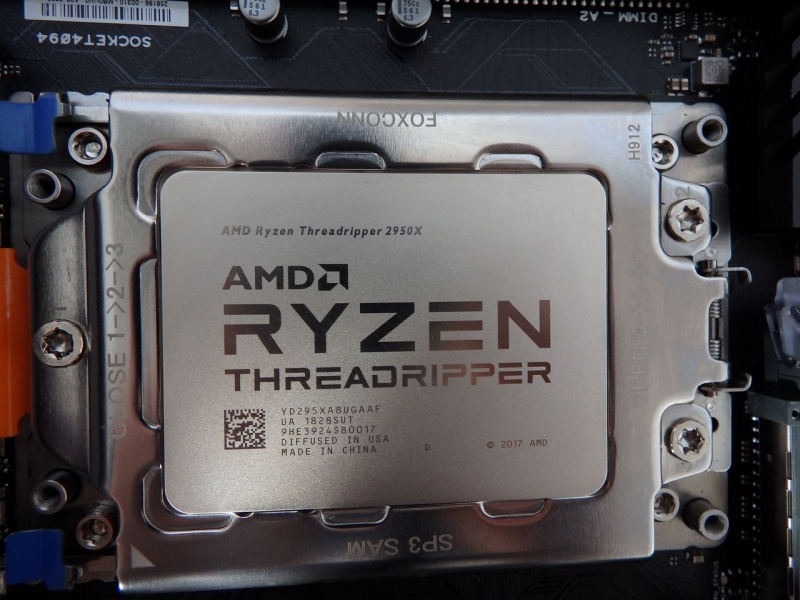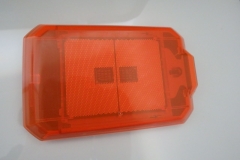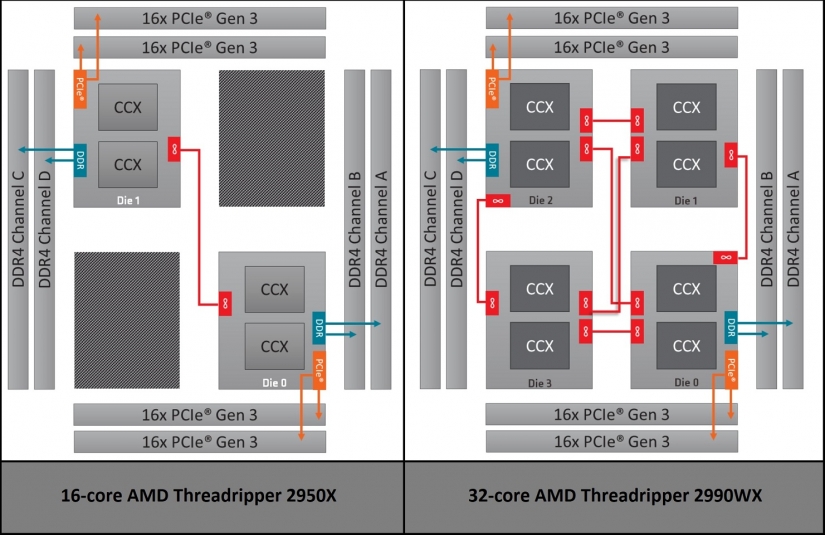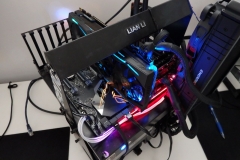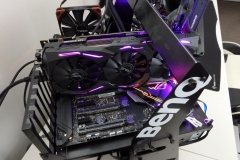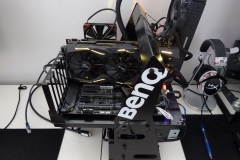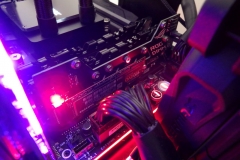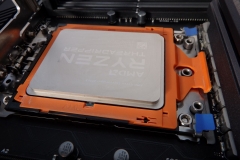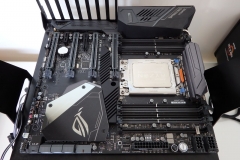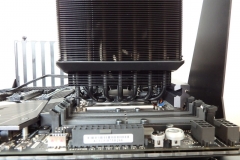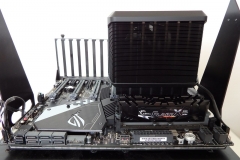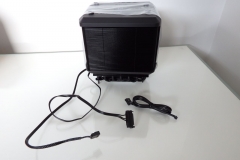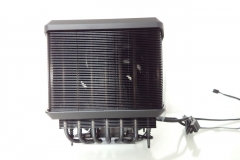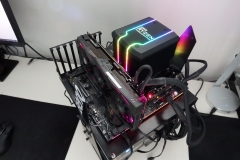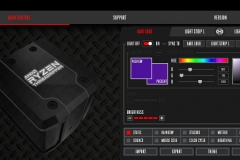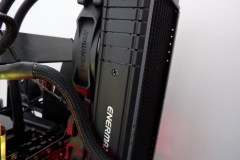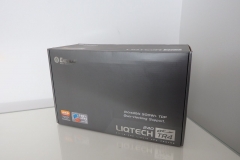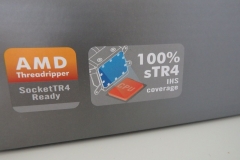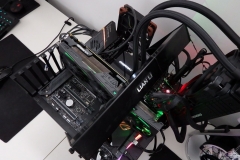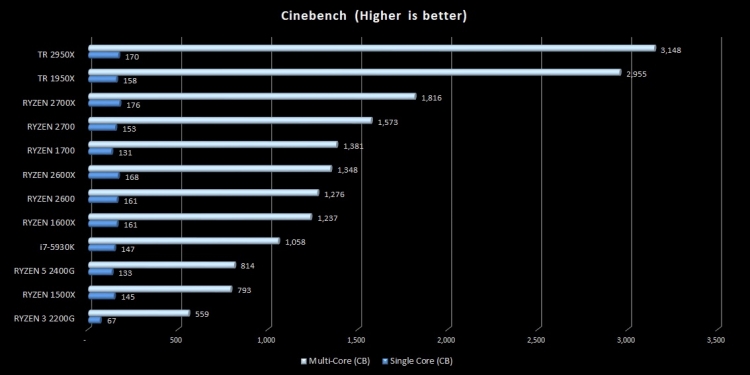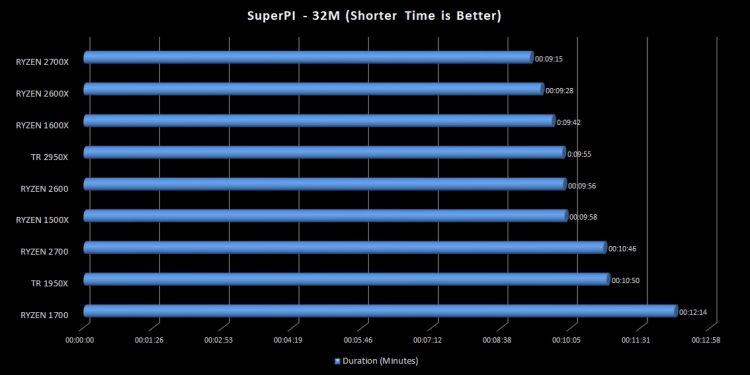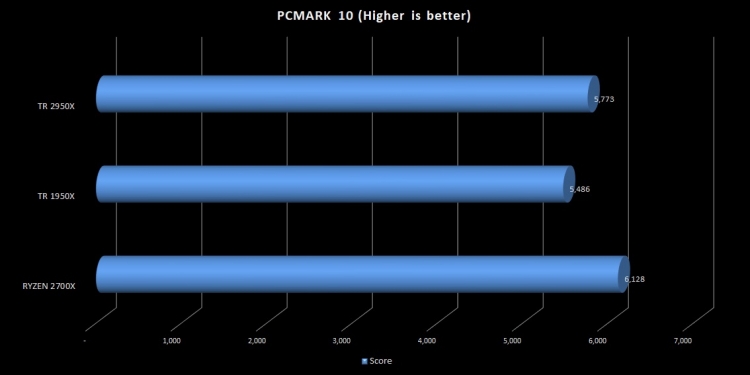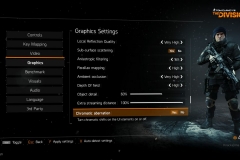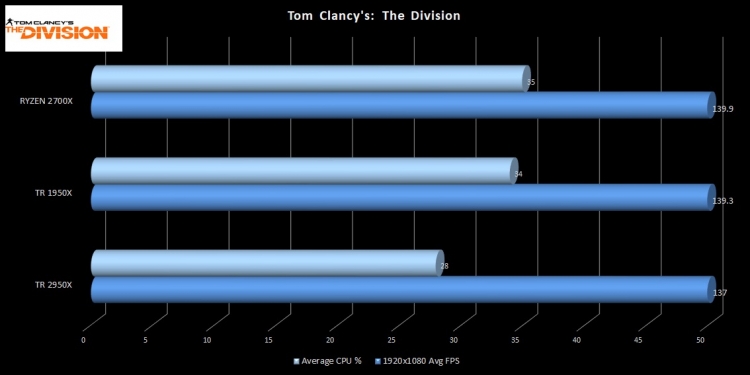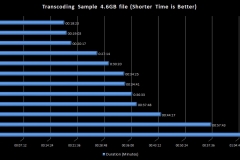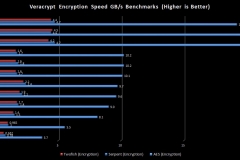AMD’s Zen architecture delivered an amazing High-End Desktop (HEDT) experience with Threadripper’s 1950X proving itself the elite pro-sumer AMD CPU of 2017. Twelve months on, AMD released the Zen+ architecture underpinning their second generation Ryzen/Threadripper CPUs and the 2950X results are impressive.
It’s an intimidating name with an intimidating price tag but the performance of Threadripper justifies both. The first generation Threadripper CPUs were well received by the market so there was understandably some keen anticipation of a second generation when the Zen+ architecture changes came to light.
Threadripper 2950X – Specification Comparison
The table below shows where the 2950X CPU sits in comparison with the first generation 1950X that it effectively replaces and the 2990WX that takes core count to a whole new level.
| AMD Ryzen Threadripper 1950X | AMD Ryzen Threadripper 2950X | AMD Ryzen Threadripper 2990WX |
|
|---|---|---|---|
| TDP | 180W | 180W | 250W |
| Core Count | 16 Cores, 32 Threads | 16 Cores, 32 Threads | 32 Cores, 64 Threads |
| Core Topology | 8 Cores ea. In Dies 0,1 | 8 Cores ea. In Dies 0,1 | 8 Cores ea. In Dies 0,1,2,3 |
| L2 Cache Configuration | 512K per core (8MB total) | 512K per core (8MB total) | 512K per core (16MB total) |
| L3 Cache Configuration | 16MB per die (32MB total) | 16MB per die (32MB total) | 16MB per die (64MB total) |
| Base Frequency | 3.4GHz | 3.5GHz | 3.0GHz |
| Boost Frequency | 4.2GHz | 4.4GHz | 4.2GHz |
| PCIe Gen3 Lanes | 64 | 64 | 64 |
| Memory Channels | Quad | Quad | Quad |
| Extended Frequency Range 2 (XFR 2) | No | Enabled | Enabled |
| Precision Boost 2 | No | Enabled | Enabled |
| Transistor Count | ~9.6 billion | ~9.6 billion | ~19.2 billion |
| Die(s) Size | 2x 213 mm2 | 2x 213 mm2 | 4x 213 mm2 |
| Process | 14nm | 12nm | 12nm |
| AUD RRP | $1189 | $1349 | $2679 |
OK, so what is Threadripper good for?
Threadripper is more than an enthusiast CPU, it’s a pro-sumer High-End Desktop CPU that can deliver compute yields of about double the enthusiast Ryzen 7 series of CPUs. It also has 64 PCIe Lanes available on the CPU which is most useful for scenarios like large scale multi-GPU configurations or platforms that need to use PCIe mounted NVMe PCIe Gen3 x4 SSD storage. The X399 chipset that supports Threadripper generation 1 and 2 CPUs supports Quad Channel DDR4 with 8 DIMM slots allowing for a larger memory footprint. Finally, the sheer number of cores and threads available under the hood deliver a serious amount of compute power that is invaluable for significant multi-tasking or resource intensive loads like rendering, transcoding or running Virtual Machines in a development environment.
I’ve been using the first generation 1950X 16core / 32thread Threadripper CPU for 12 months now on a daily basis. Workloads include voice recognition & transcription work, video transcoding, image processing, VM work, general productivity and, of course, gaming. The experience at times of heavier multi-tasking is noticeably better than on a Ryzen 5 or Ryzen 7 workstation. Gaming feels about the same as when using CPUs with half the core count.
HEDT processors like Threadripper represent overkill in most situations so these are not for everyone regardless of how much disposable income might be available. If you are a gamer and use your PC for gaming most of the time, you should be looking at AMD’s Ryzen 5 or Ryzen 7 CPUs and redirecting your funds to a graphics card and/or more solid-state storage.
Who Needs Threadripper?
AMD have clearly anticipated this question. The suggested use case and product alignment for their Desktop processors is:
| Ryzen 7 series | Ryzen Threadripper X series | Ryzen Threadripper WX Series |
|---|---|---|
Editing | Encoding Compiling | Simulation and effects |
Keep AMD’s alignment model in mind if you’re selecting your next processor and looking at Ryzen.
The old phrase “Time is money” holds true and whilst the above product series can all execute the rendering, encoding and compiling, they will each take varying lengths of time to complete the same task due to the availability of cores to do the work. Any time saved by a faster desktop CPU could be better spent on another iteration to improve the quality of the deliverable or the progression of another project. The capital cost of the faster workstation could reduce the time and effort required to execute tasks – in effect reducing the cost to provide services (and in some cases goods, depending on what they are).
Case Studies
Two HEDT case studies that I’ve seen in the past stand out. I have an associate who needs two desktops to do his job, a desktop that he uses for design and rendering and another workstation that he uses for everything else. He tried to use the one high-end workstation for both but found that when he had a render going, he could barely use his email due to the lag and those renders could take a while to finish. If he found an error in the final output of the render job, he’d have to start over and wait again. Threadripper is made for people like him, for streamers and content creators, for designers and animators and for situations where you need a serious amount of grunt to get things done quickly for other people who just don’t want to wait.
The second case study is a Threadripper owner I know with one PC in his house and he uses it for commercial video editing/production during the day but likes to kick back some evenings and play some games. His 1950X allows him to do just that and sometimes he even does both, playing a game like Battlefield 4 or Witcher 3 while the CPU encodes a production.
Review Kit Packaging
I have to talk about the review kit packaging. This was the most extravagant packaging I’ve ever seen on any product for review. Second Generation Threadripper is something special and AMD wants to make sure everyone knows it – they are driving the hype train at full speed and on testing the 2950X, so they should.
The first box contained a 2950X CPU with 2x16GB G.Skill Flare X DDR4 3200MHz kits and the Wraith Ripper CPU cooler.
The second box included an Enermax Liqtech 240mm AIO cooler with TR4 waterblock, an ASUS X399 ROG Zenith Extreme motherboard and the Cooling kit for the motherboard.
Make no mistake, this is one of the most expensive and high-spec test platforms we’ve had in the lab. The ASUS ROG Zenith Extreme is without a doubt the most intimidating and fully featured motherboard I’ve ever seen. It’s the Rolls Royce of motherboards and I’m not just talking X399 series. This board has all the smarts you could ask for, beautiful aesthetics and flawless build quality. There is so much fun to be had with the X399 Zenith Extreme that we’ll be reviewing it separately.
Scaling to meet the market and scaling FTW!
AMD got their Zen architecture right with regard to scaling. The ZEN CCX package design has proven to scale nicely with the ability to use multiple packages in a CPU, disable cores or dies and even integrate it with a VEGA graphics processor on an APU with their Infinity Fabric.
Let’s do a quick recap on the CCX package as covered in previous reviews.

Each Ryzen CPU Complex (CCX) contains 4 cores/8 threads and is scalable in that more than one CCX can be implemented in a ‘Zen’-based product. The Ryzen 7 processors use 2 CCX with all cores enabled, Ryzen 5 CPUs also have 2 CCX but have 1 or 2 cores disabled in each CCX, depending on the model. The exception is where Ryzen APUs (2200G and 2500G) have one CCX package and a VEGA graphics processor on the die. In 2017, Threadripper CPUs took this to the next level with 4 fully enabled CCX modules in the implementation. Now, in 2018 we see it taken even further with 8 fully enabled CCX modules on the 2990WX.
Using their patented ‘Infinity Fabric’, AMD has paired 4 CCX across 2 dies for the 2950X and 8 CCX across 4 dies on the 2990WX. Dies 0 and 1 have 2 memory channels attached which provides a total of 4 memory channels overall.
The image below shows how the 2950X and 2990WX processors interact with PCIe lanes and DDR4 memory channels. The 2990WX has 2 more dies enabled (4 more CCX packages) that deliver the additional 16 cores to make up the 32 cores available in the processor. The additional 2 dies (Dies 2 and 3) deliver double the available cores with all I/O traffic going through dies 0 and 1. The 2990WX is a monster of a CPU with the most compute potential we’ve seen in the HEDT space.
Moving to a 12nm production process from 14nm increases efficiency and gives the 2950X a nice little speed increase over the 1950X which is good and to be expected but this gets multiplied out further thanks to Precision Boost 2.
Precision Boost 2
First generation Threadripper CPUs used the previous iteration of Precision Boost. This allowed the CPU to boost the clocks of up to 4 threads on each die for a “4-core boost” state or, alternatively, an “all core boost” state of 9 or more threads on any die. Precision Boost 2 works a little differently and taps into more performance potential with an algorithm that chases the highest frequency it can until the CPU hits either a thermal or electrical limit, or until it hits the rated boost frequency of the core. Precision Boost 2 will stop “boosting” the frequency when the first of the limits is reached and the increases in speed occur in 25MHz increments.
A conceptual diagram of the way this works is below. The orange line represents the first generation Precision Boost approach whilst the yellow line is a representation of how Precision Boost 2 could behave with appropriate power and cooling. The triangular area on the graph above the orange line and below the yellow line represents the accessibility of clock cycles previously not available unless overclocking.

During my testing I saw the core clocks behave more evenly around the 3.9-4.1 GHz area under stock settings but there were regular peaks into the 4.4GHz full boost. Sustained load testing didn’t exactly match the conceptual diagram above but the behaviour I observed didn’t contradict the diagram either.
Precision Boost Overdrive
When testing the 1950X last year, we could either have Precision Boost and XFR running or a manual overclock. The manual overclock of 3.9GHz threw both PB/XFR and the energy efficiency features out the window but delivered better performance overall for multi-threaded applications. The overclock sacrificed the top speed of 4.2GHz of 4 cores for the benefit of the 16. It was a shame there was no middle-ground back then but with the 2950X there is another option – Precision Boost Overdrive.
Precision Boost Overdrive delivers another option by allowing the CPU to still hit the max boost clock, retain the efficiency functionality but also get more performance from the other cores for a better overall result. This is possible by allowing the user to change the thresholds that the Precision Boost 2 algorithm uses.
There are three thresholds that can be increased. AMD explains this as:
- Package Power Tracking (“PPT”): The PPT threshold is the allowed socket power consumption permitted across the voltage rails supplying the socket. Applications with high thread counts, and “heavy” threads, can encounter PPT limits that can be alleviated with a raised PPT Limit.
- Thermal Design Current (“TDC”): The maximum current that can be delivered by a specific motherboard’s voltage regulator configuration after warming to a steady-state condition through continuous operation
- Electrical Design Current (“EDC”): The maximum current that can be delivered by a specific motherboard’s voltage regulator configuration in a peak (“spike”) condition for a short period of time.
Remember that Precision Boost 2 will chase the highest frequency until one of the following limits is hit:
- Thermal threshold
- Electrical limit
- Rated frequency
What Precision Boost Overdrive offers is a way to increase that electrical limit so if the CPU/System cooling solution is effective enough to control the thermal threshold, then the speed is likely to get closer to the rated frequency of the CPU resulting in possibly a better/flatter curve with all the benefits of XFR and Precision Boost 2 without the need to manually overclock in the traditional sense.
Precision Boost Overdrive is considered overclocking and will still void the warranty so be warned.
Ryzen Master – New features
Ryzen Master evens the playing field to a large extent with regards to software based overclocking (i.e. overclocking without using BIOS). All the motherboard vendors provide software to do it but the AMD Ryzen Master application provides a level of consistency across all X399 motherboards and it’s easy to use.
The latest version also gives more visibility over the capabilities of the CPU, the fastest core and other metrics that can be useful to enthusiasts.
AMD has listed the new features of Ryzen Master as:
- Precision Boost Overdrive (PBO): PBO allows the SoC to consume more power from the socket, and exploits additional current headroom in motherboards with VRM configurations that exceed AMD specification.
- Package Power Tracking (“PPT”): The PPT% indicates the distance to maximum power (in watts) that can be delivered to the socket by the motherboard across various voltage rails. 100% indicates maximum capacity.
- Thermal Design Current (“TDC”): The TDC% indicates the distance to maximum current (in amps) that can be delivered by the motherboard voltage regulators when they have been heated to a steady state through sustained operation. 100% indicates maximum capacity.
- Electrical Design Current (“EDC”): Maximum current (in amps) that can be delivered by the motherboard voltage regulators in a peak/transient condition.
- Fastest Core Detection: The stars represent the fastest core(s) within each CCX, while the gold star indicates the fastest silicon in the entire device. The circles represent the second fastest cores within the CCXes. This can be extremely useful for breaking single-core clock speed records.
- Per-CCX Overclocking: It is now possible to independently control the clock speed of each CCX.
- Topology View: Cores in the UI are now labeled and grouped according to their physical location in the SoC.
- Quarter Core Mode: Legacy Compatibility Mode has been extended to include a 75% thread count reduction, permitting the 2990WX to temporarily behave like a Ryzen 7 2700X CPU with 2 CCX, 8C16T, and 2CH DIMMs.
Given that Ryzen Master launched a little over a year ago, the constant improvement and evolution of AMD’s performance tool is a great sign.
Memory Management
The Quad Channel DDR4 support can be configured to run in Distributed Mode or Local mode via the Ryzen Master utility or BIOS.
AMD describe the different modes as stated below:
Distributed Mode
‘Distributed Mode places the system into a Uniform Memory Access (UMA) configuration, which prioritizes even distribution of memory transactions across all available memory channels. Distributing memory transactions in this fashion ensures consistent memory performance for applications with unknown or unpredictable threading behaviour. The “consistent performance” stems from enforcing a blend of local and remote memory accesses, which guarantees that a process will always derive some benefit from the remote memory channels. ‘
Local Mode
‘Local Mode places the system into a Non-Uniform Memory Access (NUMA) configuration, which divides the processor into two “nodes” containing one die and two memory channels each. The operating system will attempt to localize a process and its memory transactions within one node before engaging the second node. Localizing workloads to a node can reduce memory throughput when threading is limited, but offers idealized latency for modestly-threaded applications that benefit from quick memory access.’
The default mode is Distributed as the Uniform Memory Access configuration is generally the better performer for Creative and Productivity applications.
StoreMI
StoreMI technology essentially ‘fuses’ a mechanical HDD with an SSD to create a single visible drive that shares the capacity of both physical drives but promotes the most accessed blocks to the fastest storage. You can add 2GB of DDR4 to the StoreMI drive as well for even better performance. I used this when testing our X470 and B450 platforms and found it great for my games libraries that can take up 1-2TB of space. Using StoreMI with a 250GB SSD and a 2TB HDD, I was able to get SSD speeds most of the time on the games that I played most often. This made a huge difference to load times without me having to manually manage windows junctions and shuffle folders around.
It’s easy to overlook StoreMI and whilst this tiered-storage solution is more likely to appeal to budget conscious consumers rather than content creators, there is still a place for it in a high end workstation. StoreMI can be used on a boot drive but it doesn’t have to be and having a 2.2TB drive that can optimise/promote 250GB of data to 500MB/s (SATA) or faster could be very handy when dealing with concept art or reference material. The learning logic seems to be very effective and our X470 benchmarks (below) show the before and after results when paring a 250GB SSD with an older 750GB Seagate Barracuda.
StoreMI is free on all X399, X470 and B450 chipset based motherboards.
Test Platform
Test Rig Specification
- AMD Ryzen Threadripper 2950X
- Wraith Ripper Cooler used for comparison only, not benchmarks
- Enermax Liqtech 240mm TR4 AIO Water cooler
- 32GB G.Skill Flare X 3200MHz DDR4
- ASUS X399 Zenith Extreme Motherboard with cooling kit
- ASUS STRIX GTX1080Ti 11GB OC
- Samsung Evo 970 NVMe 250GB SSD
- WD Blue 2TB 3.5″ HDD
- Corsair RM850x PSU
- Lian Li Pitstop test bench case
- Logitech G910 keyboard
- Logitech G900 mouse
- Logitech Z533 desktop speakers
- Kingston HyperX Cloud Revolver headset
- ViewSonic XG2703-GS Monitor – (G-SYNC disabled for benchmarking)
Installation
Installation is a little more daunting than with a Ryzen CPU. Threadripper is larger, heavier and the socket has over 4,000 pins in it that risk permanent damage if you drop the CPU and bend them. Thankfully, the process is straight forward and the protection measures are adequate so long as you take your time and follow instructions.
There are 2 levels of socket protectors and the CPU comes in an orange plastic surround to make it easier to handle. The only thing I found a little difficult on ours was that the first Screw (#1) needed more pressure to start threading than I’d have liked but this was also reported on some forums with X399 boards of all makes/manufacturers over the past year with Threadripper 1st generation CPUs. In the end, screw #1 engaged, then #2 and #3 engaged without a drama.
Cooling
AMD Coolermaster Wraith Ripper
It’s an attractive cooler that performs well with the 2950X. Our G-Skill Flare X memory modules didn’t have any issues with clearance. Acoustically, the cooler did the job quietly and well using a PWM profile but it does make a racket on the unusual occasion where you might decide to run it at the full 12V. The black powder coat is a really nice touch and looks stealthy (except for the prominent LEDs).
The heat plate is full sized and comes with pre-applied thermal compound. The screws run through the entire heat sink so you don’t need any special long screwdrivers or tools to fit it to the TR4 socket. A standard or even a small Philips head screwdriver will do the trick.
Enermax LIQTech 240 OC TR4
The Enermac AIO cooler is specifically made for the TR4 socket with the full size water block. As we had this on the open air test bench, the mounting of the radiator was less than conventional.
There was a lot to like about the Enermax cooler and it allowed me to lock down a stable all-core overclock of 4.2GHz at 1.425v. General temperatures when running at stock settings were far superior to the hefty but still effective Wraith Ripper.
Testing results
For the most part, we tested the 2950X against its predecessor the 1950X and the newer second generation Ryzen 7 flagship, the 2700X.
CPU focussed test results
Cinebench Testing – Single and Multi-Thread
Cinebench is a good way to test both single and multi-core performance. The 2950X extends the lead of the 1950X in multi-core performance and dominates the chart. The move forward is almost 6% in mult-threaded performance and 7% in single core.
Veracrypt Encryption Benchmark
The encryption benchmarks show marginal improvement between the new and the old Threadripper CPUs. AES Encryption performed the best of all but the Twofish encryption actually performed slightly better on the 1950X.
The free Veracrypt application has a benchmark utility that you can run on your own CPU for comparison purposes.
SuperPI
SuperPI is a single threaded benchmark that puts the CPUs into a single core, single thread foot race. As the results show, the 2950X’s 16 cores and 32 threads don’t help it here with the consumer-grade CPUs taking the points.
Handbrake Transcoding
The following graph shows the time taken when using Handbrake to convert the same 4.3GB MKV file to an MP4. The results below show that the 2950X benefits from the clock speed bump as it completes the payload faster than the 1950X.
Blender
We used the Classroom Blender project to compare performance of the 2700X, 1950X and 2950X. The results were in-line with the specifications with the 2700X lagging behind suffering some ‘core-envy’ and only having dual channel memory bandwidth. The 2950X pulled ahead of the 1950X with that extra clockspeed helping to complete the same payload about 7.5% faster.
PCMARK 10 – Overall PC experience
PCMark 10 testing is a mixed bag, clearly not benefitting from the quad channel memory bandwidth or the extra cores with the 2700X taking the points. The 2950X outscored the first generation 1950X which demonstrates a move forward when comparing like-for-like HEDT processors.
You can download PCMark 10 from Futuremark here and test your setup against our test systems.
Gaming
All tests were undertaken at 1920×1080 so as not to bottleneck the system at a GPU level. The GTX 1080Ti can handle higher resolutions with ease but for the purpose of CPU testing, I wanted to see the difference at lower resolutions where the CPU could have more of an impact.
3DMark
The Firestrike results are consistent with the 2950X doing well in all of the physics scores and recording a subtle improvement over the 1950X. Interestingly, the overall scores are generally even and the 2700X doesn’t lag as far behind as we saw in the rendering or transcoding tests.
Tomb Raider
Tomb Raider is an older DX11 benchmark but it’s consistent and tends to even out the field – especially at 1440p. For this test we kept the usual settings the same but dropped the resolution down to 1920×1080. We used the following settings:
As expected, the scores were all within margin for error and had the CPUs performing equally.
Hitman (2016)
The DX12 performance at 1920×1080 with all other settings as shown below:
Unlike Tomb Raider, Hitman in DX12 seemed to benefit from the extra CPU power available but the result wasn’t to the scale of the architectural advantage that the 2950X possesses. The placing of the 2950X, 1950X and 2700X was expected but I’d expected the Threadripper CPUs to be a little further than 7FPS in front.
The Division
We used the settings as per the gallery below but at 1920×1080 resolution.
The average frame rate is considered a tie here but when looking at the average CPU Utilisation, the 2950X is only running at 28%, leaving a lot of unused clock cycles for other tasks or streaming conversion. Looking at the utilisation of the comparison CPUs, the bottleneck in this benchmark appears to be the GTX 1080Ti.
GTA V
Grand Theft Auto V was tested using the settings below.
The performance steps down from the new 2950X, 1950X and then 2700X in what is still considered a tight group
Ashes of the Singularity
This might be more benchmark than game but it is still a basis for comparison. The test was done at 1920×1080 on the High preset using a CPU Focused benchmark.
The results here are within 9FPS from best to worst with a CPU focus.
Gaming Performance Conclusion
It’s fair to say that the $1349 price tag of the 2950X is really hard to justify for a gamer when a 2700X can be had for $469. This doesn’t take anything away from the Threadripper CPUs but reinforces AMD’s product alignment matrix where Ryzen 7 is recommended for PC Gamers. From our testing, most PC gaming enthusiasts could also get away with a 6 core/12 thread 2600X CPU.
What the testing also tells us is that Threadripper owners are not at a disadvantage from a gaming perspective. All of these tests were run with the 1950X and 2950X running stock creative mode configurations with all cores enabled. There will be some areas where games run better in Game mode with 8 cores disabled but for the purposes of testing, we kept the configuration the same for all tests, creative, productive and recreational.
If you need a High-End Desktop for a specific purpose but also want to game on it, Threadripper will do the job and in many cases may let you have some fun while it handles your ‘real work’ in the background.
Overclocking
Running a CPU past its rated specification is never guaranteed and results can vary a lot between CPUs, the motherboards, coolers and differently skilled people. We tested overclocking using the Enermax Liqtech 240mm cooler as the Wraith Ripper proved effective at stock settings only.
The best benchmark-stable overclock I achieved with this 2950X was 4.2GHz using 1.425V. Under sustained load of 60 minutes, the temperatures hit 86C which proved to be the limiting factor in our testing. It felt like the CPU had more to give with a better thermal solution. I also had a 120mm fan passing air over the socket area to cool the heat sinks.
4.2GHz was better than I was expecting and the results below show a reasonable improvement in everything except Veracrypt encryption benchmarking
Power and temperatures need talking about here as well. That ‘little’ voltage tweak of 1.425V had a significant impact on the 2950X. Our system was drawing about 265W from the wall under load in blender for using stock clocks but when overclocked it was taking 460W which is a lot more than I was expecting.
Thermals were exactly what I was expecting with sustained blender load at 4.2GHz with 1.425V pushing the CPU to 86C in a 21C ambient room environment.
Pricing
At $1349, the 2950X currently sits $140 more than the 1950X it replaces. $140 is a fair premium for the higher boost clocks, XFR2, Precision Boost 2 and Precision Boost Overdrive advancements.
The price is aggressive and will be compelling for users with heavy, professional or even semi-professional needs.
Gamers and enthusiasts will find it hard to justify $1349 when a $469 Ryzen 7 2700X might do the job almost as well or the same – depending on their needs. These ‘needs’ are not likely to include quad channel memory, 64 PCIe lanes or 16 cores.
There will also be a minority of people out there that build a system once in a blue moon and want it to last forever. They spend up and want the duck’s guts when they buy that dream rig. Who am I to tell them that they probably don’t need Threadripper? They’ll buy one anyway.
Final Thoughts
The 2950X is a nice step forward from an already impressive 1950X to include improved XFR and Precision Boost algorithms. For early adopters who bought the first generation Threadripper CPUs, don’t feel bad as the difference doesn’t justify an upgrade in terms of the ‘X’ series. The best part is that if you invested in a Threadripper last year and want to move to one of the newer ‘WX’ series of CPUs, you can do this without needing to change anything else. AMD has maintained backward compatibility so the only thing you will need to keep in mind is a motherboard firmware update but you will be able to leave everything else as is on an X399 platform.
Moving to 12nm from the first generation 14nm gives the 2950X a 200MHz boost clock advantage and voltage reduction over the 1950X. Despite the handy performance increase from our stable overclocking results, if I was running a 2950X Threadripper my preference would be to just let it do its thing with XFR2 and Precision Boost 2 working as designed.
The ASUS X399 Zenith Extreme is the Rolls Royce of motherboards and it gave the 2950X every opportunity to shine. Although it has a high price tag, when you’re spending more then $1250 on the CPU is it really that much of a leap to get the most fully-featured board available as your core platform? This board will get its own review in the next week or so.
Cooling and clean power supply are both important to Threadripper. Under load, thermals of the CPU and motherboard can creep up so ensure that your system has adequate case airflow across the socket area. There is a temptation to use quiet fan curves and in many cases this is fine but be aware that setting the fan curve a little more aggressively can give XFR2 more opportunity to increase the clockspeed with more thermal headroom.
I liked the Wraith Ripper cooler from a practical perspective – it was so simple to install with the 4 full length screws and pre-applied thermal compound. Having a full sized contact plate and 7 heat-pipes ensures that the Wraith Ripper can take as much of the heat away from the CPU HIS quickly for the fin stacks to exchange. The LED software was easy to use and the aesthetic result is great. The only thing I didn’t like was the viscosity of the thermal compound as it was more involved to remove it from the CPU IHS when changing the cooler. The Noctua NT-H1 thermal compound, for example, is much easier to remove and not overly difficult to apply. For stock installations without any overclocking, the Wraith Ripper works well. Whilst not a criticism, the Wraith Ripper will foul the first PCIE slot as it has a large footprint to contain the 120mm fan and provide adequate surface area to handle the TDP of Threadripper.
Enermax executed the Liqtech 240mm TR4 cooler well. The radiator isn’t as thick as it looks due to the radiator casing (that also looks pretty badass) but the thermal performance is still very effective. The included fans have rubber vibration dampeners and are very quiet under general operation – these can get loud when running at 12V but this scenario would only happen when overclocking. Branding is tastefully done with a backlit pump/water block and radiator sidings. The hero of the cooler is the thick copper full socket contact plate that keeps general temperatures in the 40-50C range where we saw temps about 10 degrees higher with the large Wraith Ripper. This cooler is easy to install, has a small footprint on the board for access to the components and PCIE slots.
Conclusion
Threadripper has been an undisputed success for AMD and showcases the higher end of their Zen+ architecture. The value-adds like Ryzen Master and StoreMI are legitimate extras that consumers or enthusiasts can use. Pricing is competitive, perhaps even aggressive and AMD has honoured its promise of backward compatibility for X399 with the second generation Threadripper CPUs – even with the WX series that has four fully enabled dies. These factors should sit well with the broader HEDT community from end users, business owners and enthusiasts who now get to enjoy compute power (and upgrades) at better prices than we have previously experienced.
Threadripper 2950X is a content creator’s best friend and has the potential to deliver great results in the productivity space where applications can use all of the available cores/threads. Of the second generation Threadripper line up, the 2950X looks to be the true sweet spot.
| AMD Threadripper 2950X | |
|
PROS |
|
|
CONS |
– Single core performance is weaker than cheaper high end Ryzen 7 CPUs |
| Awards |

